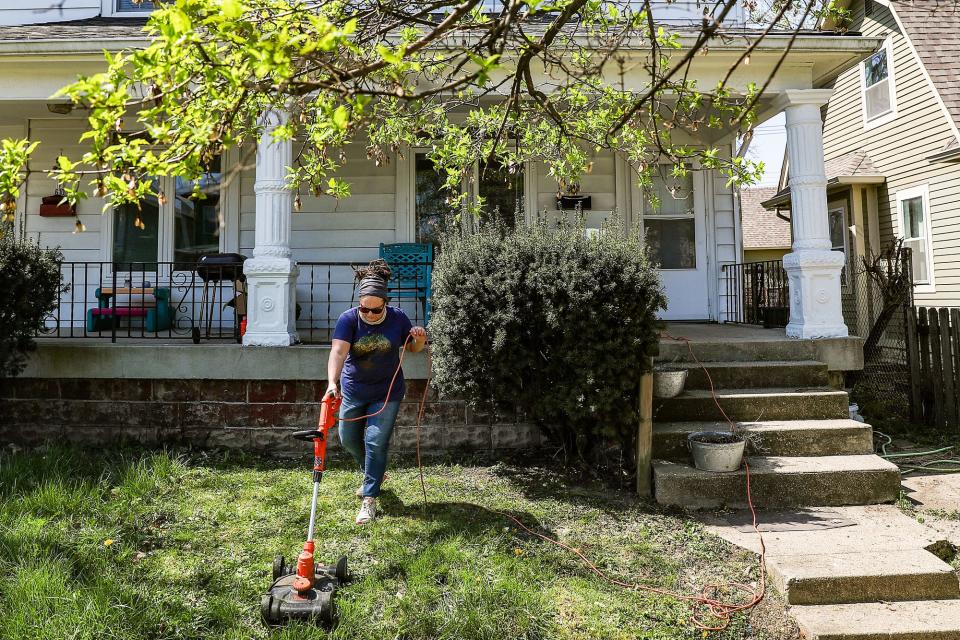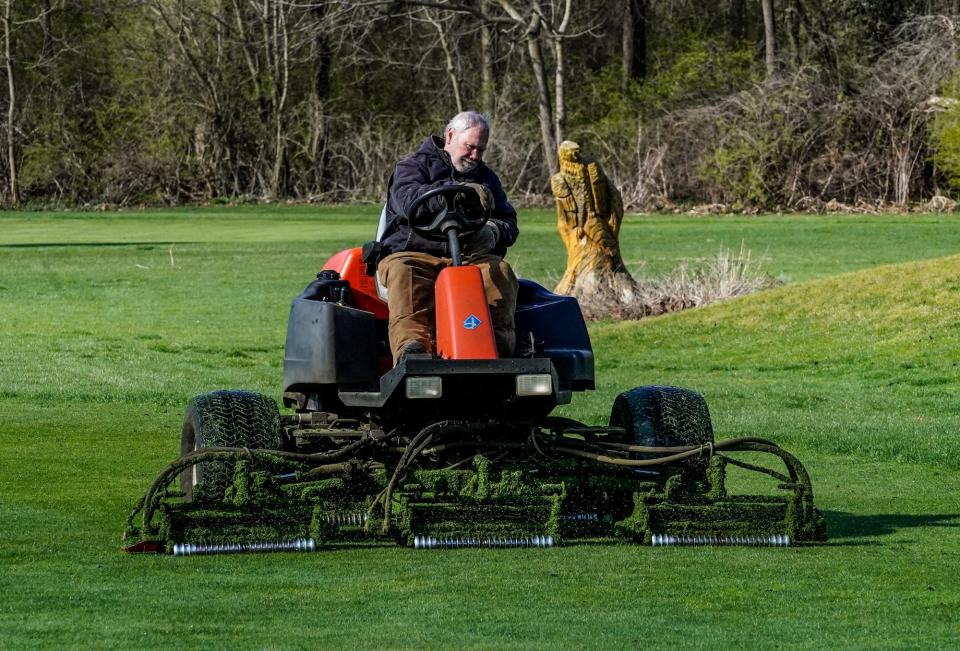Scrub Hub: Is there a good turf grass replacement that’s dog-friendly and low- or no-mow?
Before the high heat of summer weekends, and mixed among the morning birdsongs, the sweet smell of cut grass wafts though Indiana's neighborhoods.
Some Hoosiers grow Kentucky bluegrass. Some opt for ryegrass. Others are looking for the perfect blend to blanket their yards.
For this edition of Scrub Hub, we try our best to answer Ariel’s submitted question: Is there a good turf grass replacement that’s dog-friendly and low- or no-mow?
“I have a dog and I heard clover lawns are a good no-mow option, but don’t want to plant an invasive species,” Ariel wrote in our Submission Form.
There's no straight-forward answer here, but there are plenty of potential alternatives.

Short answer: Cale Bigelow at Purdue University’s Turfgrass Sciences program said there are two sometimes competing aspects to answer this question: durability and maintenance.
“It’s a tall order," Bigelow said, "to get both things on the same plate.”
Pets can damage lawns by doing their business in the grass and even just walking and running across the yard. This means a homeowner might want to opt for a yard filled with something durable, which is typically the faster growing grasses. These will of course require more maintenance, so will certainly not be no-mow.
Enter fescue.
Bigelow said a lot of homeowners will find tall fescue easy to work with. Fescue grass is more durable than some other grass species and it is also lower maintenance. Tall fescue is smaller sized and has finer-leafed blades with a nice color.
Scrub Hub talks ticks: Are ticks across Indiana getting worse? Should Hoosiers be worried?
Scrub Hub on mosquitoes: What is mosquito control, and does it hurt the environment?
“It can be really durable once established, but if you were to walk on it with bare feet, it is not going to be as soft as something like Kentucky Bluegrass,” Bigelow said.
Fescues are low-maintenance only in low-traffic areas, but the species does have a little bit of salt-tolerance. This is helpful because urine from cats and dogs contains salts.
Aaron Stump, habitat programs manager with Indiana Wildlife Federation, cautions folks considering no-mow options to temper their expectations.
“There is no ecologically friendly way to have the standard lawn that we see in most of our residential neighborhoods,” Stump wrote in an email. “A low grass, constantly disturbed by mowing, and free of weeds is not natural and cannot be maintained in an ecological manner. If you want truly no mow lawns, the only option is to simply stop mowing.”
If opting for something completely different, such as clovers, there are a handful on non-invasive choices.
Only sweet clovers have been researched for any potential of becoming invasive, according to a Purdue Extension Weed Science article.
“It is suggested that, if possible, to refrain from using sweet clovers and if used to take extra precautions to inhibit their unsolicited spread,” the article says. “As for the other clovers, they are not presently on any Indiana based invasive species list that I am aware of and are still used as valuable forages and for bees.”
White prairie, foxtail prairie and purple prairie clovers are all listed as native in the article, as well as yellow-owl’s clover, buffalo clover and running buffalo clover.
Indiana’s Department of Natural Resources, in 2004, assessed sweet clovers in a state report and recommends caution when considering these types.
“Do not buy sell, buy, or plant yellow or white sweetclover in Indiana except where used for soil fertility and only if the sweetclover is not allowed to set seed,” the report says. “If existing stands of sweetclover are being used as a nectar source for bees, we recommend best management practices be used to limit its spread.”
Micro clover has become a popular choice for lawns, Stump wrote, but these are non-native and “introducing non-native species on a large scale can be ecologically devastating.”
Long answer: There is no simple, clear choice when trying to maintain a durable, low-maintenance lawn. Some grasses have more vigor, but those will require the lawn owner to get out and mow. Low-maintenance options might not grow uniformly giving weeds a chance to crop up.
There are some companies offering slow-growing Kentucky bluegrass, Bigelow said, which could cut down the number of times a homeowner needs to mow in half, but he would caution people that don’t want to mow at all.
“Regardless of where you live, there is not perfect grass,” Bigelow said. “You can’t check every single box. If you want to rank by criteria, tick off three of the four big things for you.”
Others are reading: Noblesville shuts down community garden that fed neighbors in distressed area
Indiana lawn tips: Mowing incorrectly, fertilizing too early and other ways you're ruining your lawn
Sedges are also used to replace standard grasses, but they require knowledge of the area’s conditions as well as the correct species of sedge, Stump wrote. Much like some fescue, sedges will clump together, not creating that sharp, full looking lawn someone might be expecting
There is a best option, however, Stump wrote: eliminate lawns as much as possible and replace them with native gardens.
If only a small portion of someone’s lawn is used for recreation, Stump suggests converting the rest if their neighborhood allows it.
Rain gardens are a great starting point, Stump wrote, and offset soil erosion caused by turfgrasses.
“Short lawns don’t slow water moving across the surface, nor do their shallow roots filter water traveling through the soil,” Stump wrote. “As a result, lawns lead to polluted, warm water entering our waterways and degrading their quality.”

It seems there are plenty of choices when considering non-traditional lawn plants and making a change will take some research to find what works best for each person’s needs.
To help consumers along their lawn journeys, Purdue has a few phone applications that might help.
The Purdue Turf Doctor can help homeowners address any problems they notice in their lawns. The app diagnoses 135 grass disorders and has detailed descriptions and photos to help users figure out what is wrong.
The university also has the Tomato Doctor and Tree Doctor apps that will help identify common pests found in Hoosier yards.
Hoosier homeowners have plenty of options to consider when trying to replace turfgrass with something low-maintenance, and there are plenty of non-standard options, too.
“It’s hard to have something worse than a lawn; a non-native plant that requires constant watering, mowing, fertilizing, and herbicide to maintain,” Stump wrote. “The best advice I can give, and it’s no small ask, is to reconsider how our properties interact with the world around us and adjust accordingly. There simply isn’t a place for expansive lawns in the modern world given what we know about their impact.”
Karl Schneider is an IndyStar environment reporter. You can reach him at karl.schneider@indystar.com. Follow him on Twitter @karlstartswithk
IndyStar's environmental reporting project is made possible through the generous support of the nonprofit Nina Mason Pulliam Charitable Trust.
This article originally appeared on Indianapolis Star: You may be surprised by the best lawn alternative in Indiana

